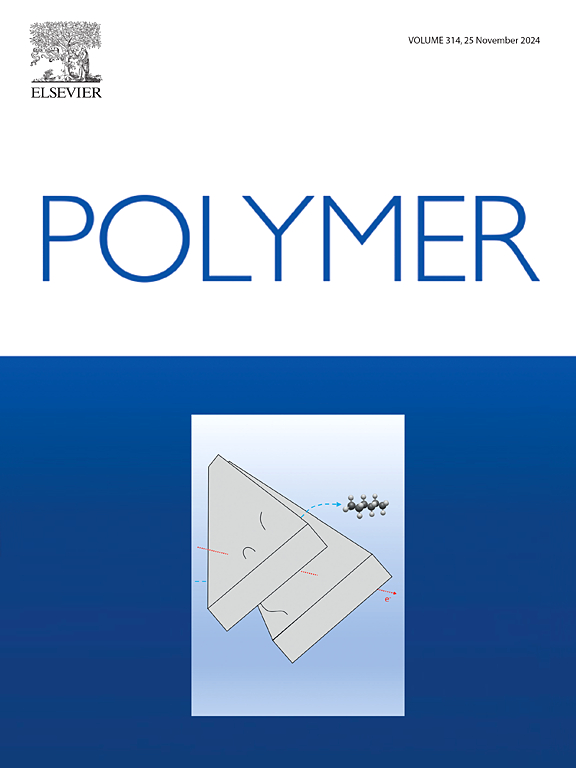外场诱导高速烧结聚氨酯共价自适应网络
IF 4.1
2区 化学
Q2 POLYMER SCIENCE
引用次数: 0
摘要
与选择性激光烧结(SLS)相比,粉末基高速烧结(HSS)提高了打印效率。高强合金的层时间缩短,要求粉末的快速熔化和凝固,这对传统的印刷粉末材料,特别是粘性弹性体是一个很大的挑战。本文合成了一种含Diels-Alder键的动态交联聚氨酯(PUDA),并将其应用于HSS。在PU中加入动态DA键可以使聚合物链在红外光加热下解离,并导致快速弛豫、扩散和解/重缠结,解决了传统PU面临的烧结不完全和层间相互作用弱的问题。结果表明,在合理尺寸精度下,PUDA零件的极限抗拉强度(UTS)和断裂伸长率(EaB)可分别达到8.1 MPa和249%。与热压型聚氨酯相比,HSS型聚氨酯的UTS降低了58%,而普通TPU的UTS降低了77%。除了烧结质量外,由于其快速熔化和凝固,PUDA的烧结速率提高了40%,这对于大批量生产的增材制造至关重要。本研究表明,在PU中加入DA键可以大大提高烧结速度和烧结质量,这为开发适合HSS的弹性体材料提供了一个有价值的方向。本文章由计算机程序翻译,如有差异,请以英文原文为准。

External Field Induced High Speed Sintering of Polyurethane Covalent Adaptable Network
Powder based high speed sintering (HSS) improves the printing efficiency compared to selective laser sintering (SLS). The shortened layer time for HSS requires quick melting and solidification of powders, which is a big challenge for traditional printing powders materials, especially the viscous elastomers. Herein, a dynamic cross-linked polyurethane containing Diels-Alder bonds (PUDA) was synthesized at kilo scale and used for HSS. The incorporation of dynamic DA bonds into PU enables the dissociation of the polymer chain under IR light heating, and will lead to fast relaxation, diffusion and dis/re-entanglement, addressing the problem of incomplete sintering and weak interlayer interaction faced by conventional PU. As a result, the ultimate tensile strength (UTS) and elongation at break (EaB) of PUDA part with reasonable dimensional accuracy can reach 8.1 MPa and 249%, respectively. The UTS of PUDA by HSS decreased by 58% compared with the hot-pressed one, whereas for the normal TPU it is 77%. Besides sintering quality, the sintering rates for PUDA is enhanced by 40% because of its fast melting and solidification, which are crucial for additive manufacturing as it comes to high-volume production. This present work demonstrated that the incorporation of DA bonds in PU can greatly improve both the sintering rates and quality, which represents a valuable direction for developing HSS suitable elastomer materials.
求助全文
通过发布文献求助,成功后即可免费获取论文全文。
去求助
来源期刊

Polymer
化学-高分子科学
CiteScore
7.90
自引率
8.70%
发文量
959
审稿时长
32 days
期刊介绍:
Polymer is an interdisciplinary journal dedicated to publishing innovative and significant advances in Polymer Physics, Chemistry and Technology. We welcome submissions on polymer hybrids, nanocomposites, characterisation and self-assembly. Polymer also publishes work on the technological application of polymers in energy and optoelectronics.
The main scope is covered but not limited to the following core areas:
Polymer Materials
Nanocomposites and hybrid nanomaterials
Polymer blends, films, fibres, networks and porous materials
Physical Characterization
Characterisation, modelling and simulation* of molecular and materials properties in bulk, solution, and thin films
Polymer Engineering
Advanced multiscale processing methods
Polymer Synthesis, Modification and Self-assembly
Including designer polymer architectures, mechanisms and kinetics, and supramolecular polymerization
Technological Applications
Polymers for energy generation and storage
Polymer membranes for separation technology
Polymers for opto- and microelectronics.
 求助内容:
求助内容: 应助结果提醒方式:
应助结果提醒方式:


